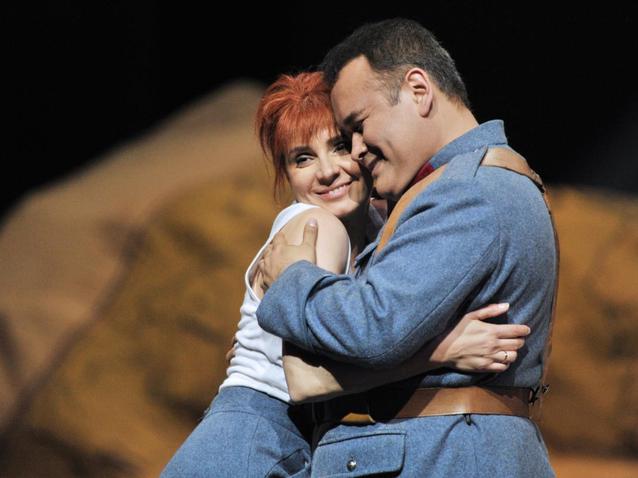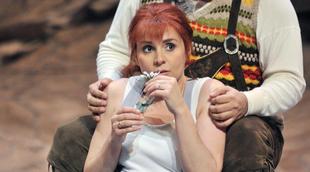 © Antoni Bofill
© Antoni Bofill
Very often the experience of opera takes on an exclusively artistic or aesthetic character and we live it as an experience of the spirit. Sometimes, though, the experience of opera resembles more that of a sports event, or a risk sports event to be more precise. We are then in front of a form of vocal athletics. It is a different experience, with lots of adrenaline, very gratifying in the moment and perhaps less so in the long term.
La fille du régiment, by Donizetti, is an opera of peak maturity in the composer’s trajectory, coming after L'elisir d'amore, Lucia di Lammermoor or Roberto Devereux, where he structurally follows the model of the French opéra-comique. The plot’s events are minimal and the dramatic consistency very scarce, with ‘cardboard’ charactersthat are basically constructed out of costumbrist clichés, altogether seasoned with a simple even more cliché and cardboardpatriotism.

Sabina Puertolas (Marie) ; © A.Bofill
This tender and inoffensive little sentimental comedy that takes place in a postcard type Tyrolean landscapecould have been one of those titles that end up sleeping peacefully in the archives as a“minor piece”.
The reason why this is not the case is because it contains “Pour mon âme", the famous tenor aria with nine high Cs: pure elite vocal athletics. It doesn’t matter that in the second act, in the "Pour me rapprocher de Marie", the phrasing is longer, richer and more complex and that it ends with a very dangerous D flat, making this aria much more difficult to sing. The nine high Cs take all the merit and the total attention of the audience, which waits expectantly to witness the moment where the tenor passes the risky test.
"Pour mon âme" lasts just over two minutes in total. If in those two minutes you are capable of placing clearly, neatly and well rounded the nine high Cs (especially the last one), then glory waits for you at the other end of the epic feat and you have your job done for the night.
The Mexican tenor Javier Camarena did so well in the role of Tonio that not only did he do the nine Cs, but doubled the bet and gave eighteen of them following the old tradition of conceding an encore at the request of the enthusiastic audience, which ruins the little dramatic consistency and continuity that the piece has left.
Camarena, who was already much celebrated recently at Liceu when singing the role of Duca di Mantova from Rigoletto, has the ideal voice for Tonio, even more so than for the Duca: a clear, quite transparent voice with little body but clean high register, with crystalline sparkle and perfect projection. His likeability and good scenic manners, in a character that has its most valuable values in simplicity and friendliness, did the rest. He was the great winner of the night.
Marie, the female protagonist, the fille of the title, is an unfair role, as she has as much if not more difficulty than Tonio, but because she doesn’t have the nine high Cs aria always remains slightly in a second place. Sabina Puértolas did very well in the part of the score that requires a soprano leggero with facility for coloratura. Her voice is young, agile and her diaphragm runs as lightly as a hare. The timbre is perhaps not brilliant in the high register and she doesn’t have power to spare, although she has more than enough. Where Puértolas doesn’t work so well is in the two “sad” arias of the role, "Il faut partir" and, in the second act, "Par le rang, et par l'opulence". These are two very beautiful belcanto arias – which are amongst the best Donizetti and could be perfectly part of Lucia di Lameermoor – which require a more lyrical voice with more weight and thickness and with room for long and legato phrasing.

Simone Alberghini (Sulpice) and Ewa Podles (Marquise of Berkenfield);
© A.Bofill
Ewa Podles, very esteemed at Liceu, did the role of Marquise of Berkenfield. She brought great humorousness, grace and dedication but her voice was irregular, with some notes still well rounded and clear but others that were opaque and blurred, showing worrying signs of tiredness in a role that isn’t tiring.
Just about sufficient but with lack of strength and character was Simone Alberghini as Sulpice. In the spoken role of Duchess of Crakentrop there was the actress Bibiana Fernández, protagonist of some of the early Almodóvar films. Her gags weren’t very funny.
Giuseppe Finzi was a good belcanto conductor, he let the singers shine and softly accompanied them, always containing the orchestral vigour. The choir, which following the model of the opéra-comique has a lot to do, did well.
The production by Laurent Pelly, was originally –over ten years ago– from the Covent Garden. It has toured around the globe going to all the major theatres and had already been staged at Liceu in the season 2009-10. It is a very good production, intelligent, full of light with a good movement of the characters and even of the choir, which is rare in the operatic world. The production main merit is that it doesn’t take the libretto seriously and rather than representing the fille du regiment, it looks as if it parodies her through a kind caricature with only a few pinches of critical causticity.
***
La fille du régiment by Gaetano Donizetti. Sabina Puértolas, soprano. Ewa Podleś, contralto. Javier Camarena, tenor. Simone Alberghini, baritone. Isaac Galán, baritone. Carlos Daza, baritone. Bibiana Fernández, spoken role. Orchestra of Gran Teatre del Liceu. Choir of Gran Teatre del Liceu. Giuseppe Finzi, conductor. Laurent Pélly, stage director and costumes. Christian Räth, staging of the production. Chantal Thomas, scenography. Production, Gran Teatre del Liceu based on the original co-production by The Metropolitan Opera from New York, Covent Garden from London and the Wiener Staatsoper. Barcelona, 16th May.
the 18 of May, 2017 | Print
Comments